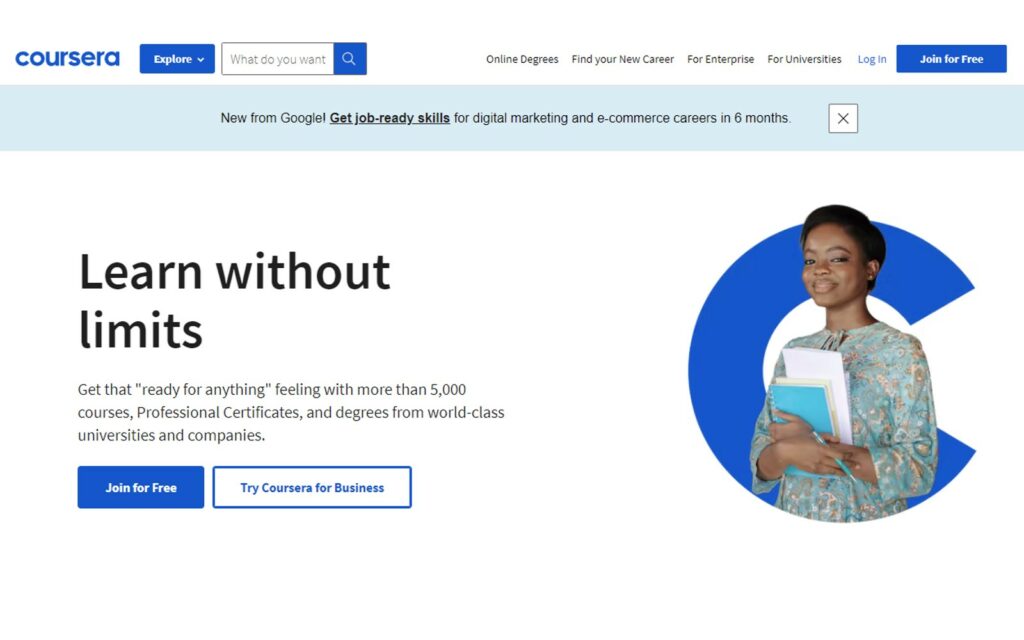How to Create an Online Course in 2023: Making and marketing an online course is one of the best methods to spread your knowledge and earn money at the same time. The majority of companies and educational institutions are investing in digital courses to keep up with the latest trends because online learning has become the new norm. Within the next five years, the eLearning market is expected to grow to $300 billion in value.
Continue reading if you want to learn how to make your own online course and make it available to everyone. This year, I’m going to provide you a streamlined, step-by-step tutorial on how to make an online course.
- You’ll learn everything from this point onwards
- Focusing on the appropriate subject.
- Demonstrating expertise in your area of study.
- Selecting the appropriate course platform and developing the course material.
- Utilizing the marketing methods that lead to the most money.
- And more…
You will discover how to confidently develop a plan for releasing your first eLearning course by following these steps.
Without further ado, let’s begin the instruction

Table of Contents
How to Create an Online Course:

Naturally, professionals, business owners, and educators are choosing to create online courses to share their skills. Online courses have grown in popularity among students, which, in my opinion, has only helped make online education more widely accepted.
I’m even more convinced that online courses should be developed given the knowledge that both my parents and colleges use them.
A successful online course launch requires a number of stages. Here are the steps you need to take to ensure your course is a tremendous success, starting with course production and price all the way through to promotion.
Research the course topic and choose it
The hardest but also most important step in choosing a course is choosing a topic.
You really cannot take this lightly at all. The outcome of your course will depend on this. A course won’t succeed if it doesn’t address a problem for a particular online audience.
Think of yourself as a solutions supplier with real value to offer the market rather than merely a “course maker.”
I advise you to start your market research experiments by posing the following query:
Immediately after the above point, You must genuinely provide the populace an answer.
For instance, it makes perfect sense for me to establish a blogging course, but it makes no sense whatsoever for me to produce a dog training school. Don’t base your entire curriculum on a few haphazard search results. Use it as the tool that it is.
To build an online course, you don’t need to be an expert in the field; all you need to do is be a step ahead of your intended audience.
The fact that there are countless options for designing online courses is another thing to keep in mind. You may develop an online course on any subject under the sun, from cooking classes to the fundamentals of jujitsu.
But here’s some personal guidance: always choose a subject you’re enthusiastic about (it also helps if you have formal training in it.) For instance, if you have the know-how and drive to see it through, you can write guitar instructional even if you’re an accountant.
Naturally, that doesn’t imply you shouldn’t develop an online course on a subject in which you are an authority! By choosing such a subject, the course development and production phases will be easier and more manageable. Additionally, it will guarantee that your students can gain professional-level value from the course and see outcomes.
Research the market for the subject

You need to look for a topic for your course, but you also need to consider whether your intended audience will be interested in it enough. The majority of online course producers believe that their course may not be successful if there are already numerous courses on the subject they have chosen. This isn’t always the case.
There is a demand if there are many courses available on the subject. The key to selling courses successfully is identifying the areas of demand and offering distinctive and superior solutions.
You can look at popular online learning platforms like Udemy and Coursera to get a better understanding of the finest course ideas in your industry. You’ll gain a solid understanding of what the majority of online students and learners are seeking for in your specialty by browsing these sites.
In other words, in the first two steps, you need to identify the sweet spot at the intersection of a subject you are knowledgeable and skilled at, one that is in demand, and one about which you are enthusiastic (or may become). Once all of these boxes have been checked, you can choose that topic (or perhaps a few themes) and go to the next phase.
Develop Your Credibility to Become an Expert
You probably noted that I emphasized that you need to be informed about the subject you’re developing a course on in both of the aforementioned steps. You don’t have to be an absolute expert to create your first online course, I’ve also remarked, in the same breath.
These two claims would appear to be at odds with one another, yet they are not.
While it is true that you should have a fundamental understanding of the course topic you will be teaching, you can also learn a lot as you go.
There are two advantages from doing this:
To start, you can obtain a wealth of learning objectives and content for your course videos and study guides.
Second, you’ll learn more about various subfields within the subject, which could increase the profitability of your online courses.
People are not simply interested in learning from the best authority on a subject. They want to get instruction from a person they can trust and relate to.
Being an expert is fantastic, but it’s much better if you can relate to your pupils and are eager to learn more about the subject so that you may better serve them.
Struggling to market your brand? Speak with a Marketing Consultant today
Concentrate on Your Target Market
I’m confident that you now clearly understand the subject you intend to cover in your online course. Now is the moment to comprehend your target market, or the group of people you plan to cater to.
Being precise is important because not every issue is appropriate for every audience. Make sure your target audience is relevant to the topic you have chosen, well-defined, and actionable.
Some of the demographic parameters you should take into account are as follows:
- Age range of your target market
- The gender that enrolls in your course the most
- The target audience’s typical educational level
- The audience’s employment situation
The list above is not all-inclusive and may change depending on the topic you choose. The average age of online students is 34, and there are 47% more men than women among MOOC users.
Seasonality is another aspect that can determine your audience. Some courses are more appealing at certain periods, like baking classes around the holidays.
A data science course could be directed at people who want to change careers into data science, for example. You can also target audiences based on their intentions. Another course concept is to provide an online interior design school.
Finally, don’t overlook the power of social media. Social media platforms like Facebook groups, LinkedIn, and Instagram can be used to locate a target demographic quickly. This is exactly what I did for my blogging course, and it was a game-changer for determining the course’s precise perspective.

Map Out The Online Course Outline
An online course can be made and sold by anyone. However, designing an online course that is successful and yields results requires careful planning. To properly plan, test, and launch my blogging like a business course, it took me more than six months.
- Free Tool to generate outline for every course
Because of this, you must develop a thorough course outline after choosing your target subject and audience. Here, you’ll need to think about things like the course’s depth, the tone you’ll employ to appeal to your target audience, and the learning objectives.
The needs of your target audience will be the main factor in determining the course’s depth. In comparison to a cooking class, which can be lighthearted and quirky, an online course on management concepts designed for post-grads will surely need to have a more professional tone and level of detail.
Several online course development templates are available that can be used to construct an online course overview. In general, it’s a good idea to start by dividing your subject into distinct subjects, learning objectives, and further subdividing them into focused subtopics and lessons.
Do not forget that you are not need to create an outline. If you know exactly what you want to teach your students, you can get started on preparing the course material. The next item I’ll be talking about, course outcomes, will help you structure the modules, therefore I urge you don’t neglect this stage.
Frame Compelling Course Outcomes
It’s time to frame the course’s desirable outcomes once you’ve finished creating your course overview and organizing the modules. Students pay for the course to receive results, therefore how the outcomes are framed is important.
Just give it some thought. You are aware of the resources in your course and how they can benefit your pupils.
However, they are unaware of it, and until you can provide potential students a clear understanding of what they would get from the course, they won’t sign up.
You should design a course syllabus that will enable your pupils to get results as soon as possible. Make sure to prominently display these course results on your course page.
Just so that students can clearly understand what they are about to commit to and what their likely learning outcome is making personalized course outcomes ensures that only students who are interested in the course enroll in it, which is another advantage. The proper students lead to higher completion and satisfaction rates as well as fewer refund requests.
Create The Actual Course Materials
It’s finally time to dive in and start writing the real course material after you’ve finished each of the aforementioned phases. You have a wide range of options for the medium here; I suggest using video courses as they frequently have the biggest impact.
You must also offer appropriate study materials, such as PowerPoint presentations, eBooks in PDF format, or self-assessment questionnaires, in addition to the video. Every course will be different, but the main objective is to produce extra materials that aid in your students’ success.
You might like: 5 Best Strategies To Grow Your Business
Choosing which elements to include and which to omit from the course is the most frequent issue that online course developers encounter. In today’s world of information overload, you may discover numerous resources and references to utilize on any topic you choose.
Your online course’s objectives and outline will direct you at this point. Make sure to only include resources that are in line with your course structure when choosing materials for course construction. By doing this, you may shorten the creation process and streamline the course material.
You Might Like: The easiest way to live stream and record
The time has come to record the videos now that you have all the necessary materials. And you have a lot of freedom here because producing excellent online courses doesn’t require a professional filmmaker. A good webcam and screen-capture software like Camtasia are all you need.
Select from talking-head style videos, screen capture videos, or even a hybrid of the two. If you already have podcasts or webinars on the subject, don’t be afraid to use the material again for your online course. The only thing that counts is that you stay on topic and add something.

Monetize It Right
It’s time to choose how you want to make money after creating the online course content. This may entail employing strategies like creating a subscription-based model or providing a free course as a lead magnet.
You’ll also need to conduct some market research for premium courses. Examine the costs of comparable courses on well-known eLearning platforms and learn what the enrollment rates are.
The purchasing power of your target audience is a further consideration that you should make. A course shouldn’t be priced so costly that no one can afford it, after all. You’ll need to achieve the ideal mix between affordability and profitability in this situation.
One more tip on pricing: make sure the cost of your online course corresponds to the value you are offering. It’s that simple: if you want to charge more than the going rate in the market, your material must be superior than that of your rivals.
You Might Like: How to generate more leads and sales using free email marketing tool
Best Place to sell your online course:
- Udemy
- Skillshare
- Thinkific
- Teachable
- Ruzuku
- LearnDash
- Podia
- Kajabi
- Store.entrepreneur.com
- Appsumo.com
Choose the Best Delivery Channel
You must choose how you will present your course to your audiences once you have finished the aforementioned phases. There are generally three common ways to market and sell online courses. Below, each of these is covered under its own heading.
A. Platforms for online courses
One of the most widely used ways to distribute your online courses is through online course platforms. You can sell your tutorials on thriving course markets like Coursera and Udemy. These platforms offer a reliable and well-integrated setting for the upload, promotion, and sale of courses.

If you’re uploading a course for the first time, you should benefit from the popularity and marketing reach of these sites. You can add testimonies, worksheets, and even edit the course material because they make the procedure simple and comfortable.
This Thinkific review explains why it is my top recommendation for online course platforms and why I personally use it.
B. Learning Management Systems (LMS)
A learning management system, or LMS, is an online education program that can connect to your website and serve as a branding tool for your course. LMSs streamline the process of setting up a successful online course business as well as generating online courses.
Although there are many LMS choices on the market, I suggest Thinkific (iSpring or Teachable are excellent alternatives). You may completely personalize your courses using our online course platform, which also makes the process of going from course subject or idea to creation and dissemination simple.

C. Plug-ins for websites
You can choose from a wide variety of website plugins on the internet if you wish to host the online course on your own website. The most flexible platform for building an online education membership site is WordPress.
- Free Elements that can help you market and grow your online course
Make sure you have the resources in place for enrolling and validating students, regardless of the route you decide to take. Don’t forget to incorporate payment channels into your learning platform as well for simple enrollments and refunds when necessary.
Build An Email List of Raving Fans
Most online course developers and businesses make the error of believing that once their course is up and going, they’ll have a consistent source of cash. This is simply untrue; the real effort starts after you’ve created and published your course.
There is no better approach to sell your online course right now than with email marketing. Experience shows that across all digital product marketing channels, email marketing continues to offer the best return on investment.
You need to build an email list of people to whom you can actually sell your course in order to benefit from email marketing. To collect emails, I’d suggest launching a social media marketing campaign. Even a portion of your online course can be made available for free in an effort to attract leads.
You should send customized, targeted emails to students who expressed interest in your course once you have a significant email list. By doing this, you can guarantee that they can convert prospects into paying customers.
- ShortPixel products help speed up websites, reduce the size of images and documents, and save space on your. Click here to see all their products and how they may help you in your online business.
Create A Sales Landing Page
Don’t assume you’re out of the woods just yet, though, as simply catching emails only constitutes a partial victory. The greatest strategy to drive people to your course landing page and website is through sending enticing emails. But you need to make sure they have a fantastic experience once they get there.
The easiest approach to accomplish this is to design a landing page that captures the essence of your online course. The best method to guarantee that students receive complete information about the course material is to use a high-quality landing page.
You must consider a number of things while developing the landing page, including the target audience, their interests, and even your chosen topic.
Making various landing pages for various audiences and testing which ones perform best is another wise move. A split-testing model like this will help you organize the page’s layout.
Climb Into The Marketing Train
Your larger marketing strategy must include email lists, landing pages, and social media teasers if you want to be successful with the debut of your online course. In order to make sure that people learn about your online courses, you must have a persistent marketing approach.
You have a variety of possibilities here, like running early bird campaigns with alluring discounts or even search engine or social media ads. Additionally, you can advertise your target list by utilizing content marketing tactics.
The last three steps, including this one, were all focused on promoting the courses, as I’m sure you already know. This increased focus on marketing is essential since the moment you stop selling your course, you also stop marketing it.
Develop A Committed Community
You’ve now completed publishing your course. But now, creating a committed student community is an even more important step in the process that needs to be taken care of.
Online learning has some disadvantages, including the loss of much of the face-to-face interaction that occurs in a classroom setting. However, you may easily get around this by using online platforms that let you communicate with your pupils, such a social network group and webinars with video conferencing.
People enjoy interacting with other people who are traveling the same path as them since learning is a social activity. These interactions promote a sense of community inside the class and make studying more fun.
Maintaining a committed community has the added benefit of promoting your program through word-of-mouth advertising. Additionally, your course will begin to grow naturally once your customers start speaking out in support of your business.
- Unlimited downloads of 12+ million creative assets. From just $16.50/month.
Always Update Your Course Continually
The last aspect of how to make an online course that you should concentrate on is course updates. Over time, ability requirements shift, necessitating the addition of new abilities to your course repertoire.
You can’t expect a course that was released three years ago to still be of the same value to your pupils.
Make sure you maintain updating the course materials in accordance with market demands and introducing new ones as necessary.
In this manner, your online course continues to be valuable to your current students and is still relevant today.
Wrap up
I sincerely hope that this concise tutorial has been able to assist you in comprehending the full process of developing an online course.
While there are benefits and drawbacks to online learning, I think the former much outweigh the latter.
Entering this area is a fantastic option because eLearning statistics show that this market is on a rapidly upward trend.
You will benefit from sharing your knowledge and becoming a thought leader in your niche in addition to earning a reliable income source. That beats any passive marketing tactic money can buy, right there.
Want to learn more on how to Grow and Scale your online course? Click here to read more…
Please share your opinions in the comments section below.
Disclosure: I may receive affiliate compensation for some of the links below at no cost to you if you decide to purchase a paid plan. You can read our affiliate disclosure in our privacy & policy. This site is not intending to provide financial advice. This is for entertainment only.








